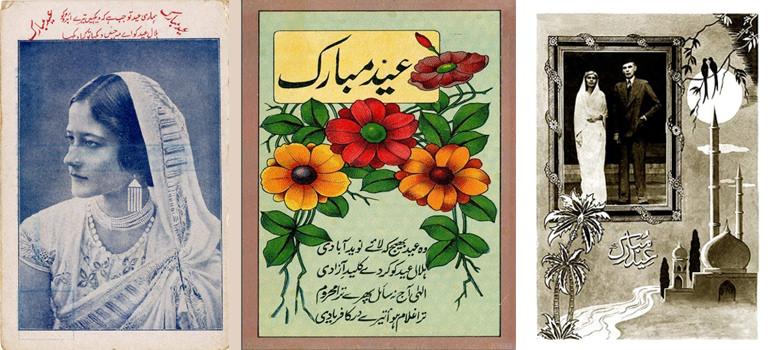The big cities, Lahore, Delhi and Bombay, had printers who specialised in these cards, which often carried Urdu poems written for the occasion.

Eid ul Fitr celebrations take a multitude of forms in our society. As the holy month of Ramzan nears the end, markets all across the country glitter with Eid paraphernalia: confectionery, clothes, bangles, mehendi, objects typically associated with this festive occasion.
But one object is usually missing: Eid cards, because the practice of sending them out has dwindled over the years. It was once routine for most families to spend time selecting, writing and posting Eid greeting cards to friends and families.
“Eid Mubarak,” an Eid card showing two girls on a swing. The printed message starts with a salutation of a young girl to her elder sister: Muhtarma aapa saheba… (Dear respected sister, my salutations. Despite the distance between us, your favours and love still provide tranquillity to my heart. While extending the Eid greetings to you, I request you to remember me forever in your prayers). Printed by Eastern Commercial Agency, Bombay. Unused, circa 1930.
From the Priya Paul Collection, New Delhi.
Courtesy: Tasveer Ghar
In the digital age, people prefer to take a faster route to greeting one another. On the eve and day of Eid, they send out a vast number of mobile text messages.
But what were those cards like? Wouldn’t it be interesting to look at some of the old ones, especially when the practice began in this country?
Here are samples from the collections of Yousuf Saeed, a filmmaker, author and archivist based in Delhi, who runs the Tasveer Ghar archive, Ally Adnan, a Dallas, US-based engineer, writer and antique collector, and Omar Khan, who runs Imagesofasia.com, a collection of vintage postcards and lithographs.
“Eid Mubarak,” a floral Eid postcard, published by Hafiz Qamruddin & Sons, Lahore (probably printed in Bombay), and posted from Lahore (sender’s name undecipherable) on 24 December 1935 and arrived at Delhi’s General Post Office on 29 December the same year for the addressee Mr Noor Elahi. The season of Eid-ul fitr or Eid-ul Zuha coinciding with Christmas in these years might have had a bearing on the use of early Eid cards. The sender’s message in Urdu is mostly damaged due to a torn corner of the card. But it basically starts with a salaam and asks about the addressee’s good health etc. Note the British India postage stamps worth half anna and three pies used on the card.
From the Priya Paul Collection, New Delhi.
Courtesy: Tasveer Ghar
On the Indian subcontinent, the tradition of sending greeting cards on Eid started in the late 19th century, when mass-printed cards started becoming available off the shelf, although some well-off Muslim families continued to sent their own hand-produced cards, sometimes with calligraphy and artistically decorated greeting message.
The trend of sending cards was probably fuelled by the expansion of the railway network, which had increased to 25,000 km in 1880 from just 34 km in 1853, when the first passenger train service was inaugurated in India. With the expansion of railway, people began travelling far away from their homes, for employment and business. It also improved the postal service. In addition, advanced printing facilities improved the quality of cards.
“Eid Mubarak, Hamari Eid to jab hai…” Eid greetings and an Urdu couplet likening the eyebrows of the beloved to Eid’s crescent, featuring Indian actress and singer Kajjan Begum, Unused, circa 1930. Distributed by Sultan Husen Bookseller, Bombay.
From the collection of Reena Mohan.
Courtesy: Tasveer Ghar
We can see that the early cards resembled European-made Christmas cards, albeit modified for Eid.
In the early years of the 20th century, Eid cards began being printed with India-specific images and illustrations. Hafiz Qammaruddin & Sons, H Ghulam Muhammad & Sons and Muhammad Hussain & Brothers in Lahore, Mahboob Al Matabah in Delhi, and Eastern Commercial Agency, Shabbar T Corporation and Bolton Fine Art Lithographers in Bombay were amongst the earliest companies that came into the business of printing Eid cards in India. Postcards with Indian Muslim architecture, produced by Raphael Tuck in London, were also used for Eid.
No discussion of these vintage Eid cards would be complete without mentioning the Urdu poetry on them written for the occasion.
“Guldasta-e Eid” (a bouquet for eid) title of the chapbook published by Rashid-ul Khairi in 1927, Delhi. Although the chapbook is not a part of greeting correspondence, such literature was produced and circulated in Muslim homes for general reading and reform in late 19th/early 20th century.
From the Yousuf Saeed collection.
Courtesy: Tasveer Ghar
میرے یاروں کو مبارک عید ہو غمگساروں کو مبارک عید ہو عاشق و معشوق رندو پارسا آج چاروں کو مبارک عید ہو
Eid greetings to my friends,
Eid greetings to my sympathisers,
Eid greetings to the lovers and the beloveds, the drunks and the pious,
Eid greetings to all four of them today.
ہماری عید تو جب ہے کہ دیکھیں تیرے آبرو کو ہلال عید کو اے مہ جبیں دیکھا تو کیا دیکھا
Eid is when I see your eyebrows
Just seeing the crescent, my dear, is no Eid.
سب لوگ تو دیکھتے ہیں کھڑے چاند عید کا مشتاق ہوں میں رشک قمر تیری دید کا
While everyone is interested in sighting the moon,
I only desire to see your face.
یہ شام عید ہے اے میرے ناقہ محمل چمک کے چل کہ دیار حبیب تک پہنچیں
It is the eve of Eid, oh my camel,
Run fast and take me to the city of my beloved.
The tradition of Eid cards continued till the end of the 20th century, diminishing with the surge of mobile and online communication.
Yet those of us who have experienced the joy of handpicking, writing, sending and receiving Eid cards cannot find a substitute in the click of buttons.
This article was originally published on Dawn.com
source: http://www.scroll.in / Scroll.in / Home> Holy Month / by Aown Ali / July 18th, 2015








